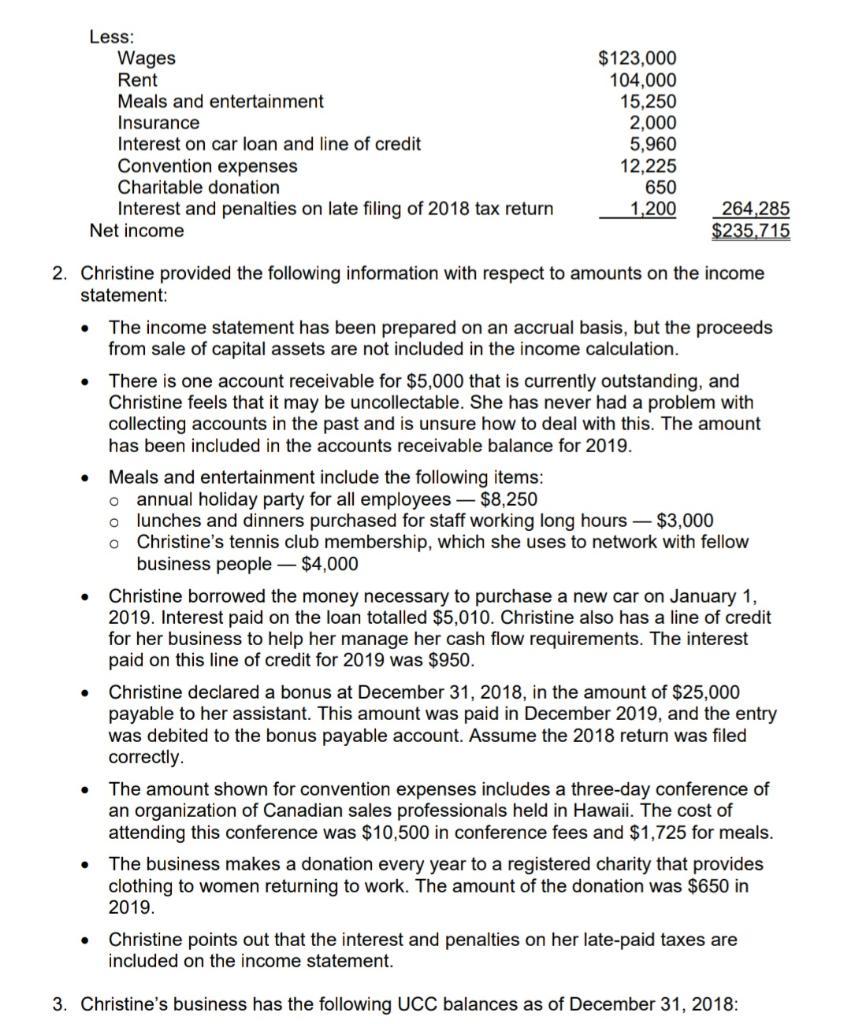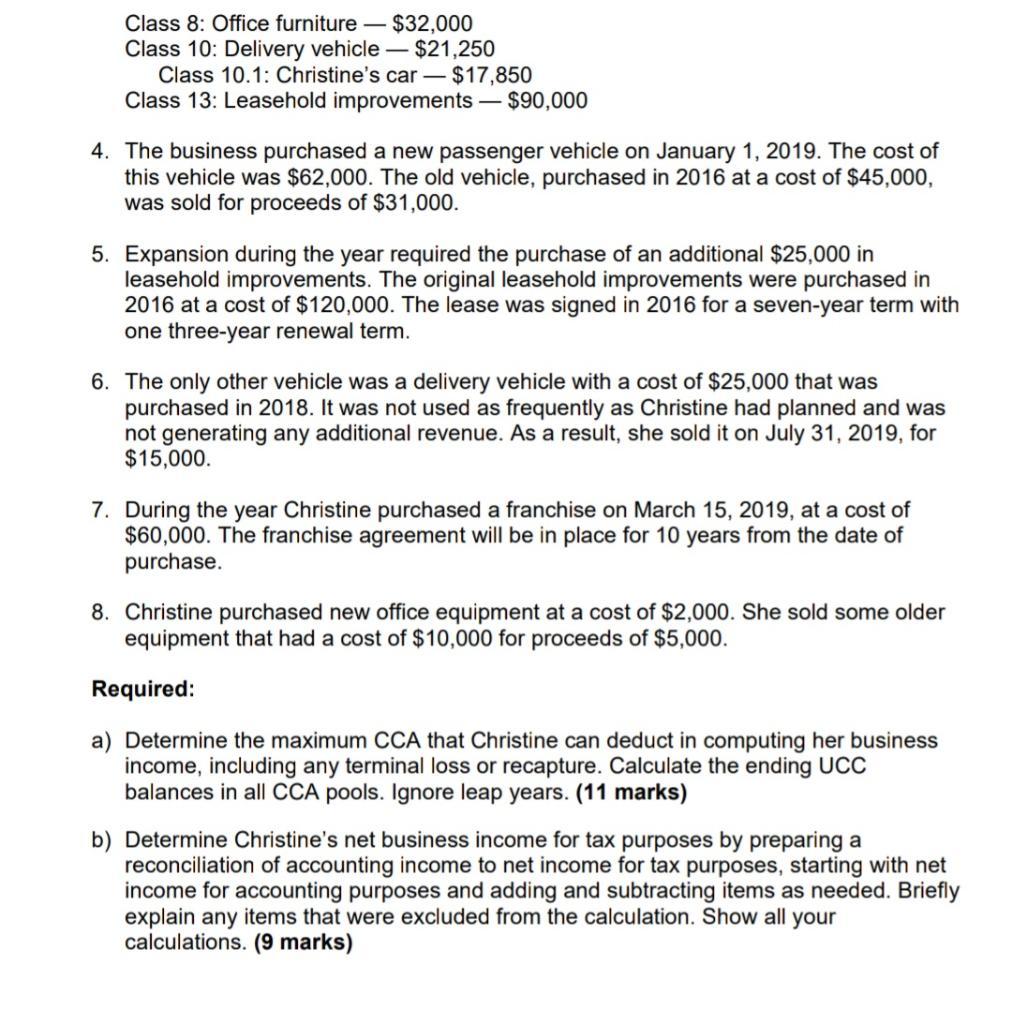Answered step by step
Verified Expert Solution
Question
1 Approved Answer
You have just finished meeting with Christine Connors, a sole proprietor, who is looking for some help with her tax situation for 2019. 1.



You have just finished meeting with Christine Connors, a sole proprietor, who is looking for some help with her tax situation for 2019. 1. Following is the income statement for Christine's business to December 31, 2019 (ignore GST): Sales $500,000 Less: Interest and penalties on late filing of 2018 tax return Net income 2. Christine provided the following information with respect to amounts on the income statement: Wages Rent Meals and entertainment Insurance Interest on car loan and line of credit Convention expenses Charitable donation $123,000 104,000 15,250 2,000 5,960 12,225 650 1,200 264,285 $235,715 The income statement has been prepared on an accrual basis, but the proceeds from sale of capital assets are not included in the income calculation. There is one account receivable for $5,000 that is currently outstanding, and Christine feels that it may be uncollectable. She has never had a problem with collecting accounts in the past and is unsure how to deal with this. The amount has been included in the accounts receivable balance for 2019. Meals and entertainment include the following items: o annual holiday party for all employees - $8,250 o lunches and dinners purchased for staff working long hours - $3,000 Christine's tennis club membership, which she uses to network with fellow business people - $4,000 o Christine borrowed the money necessary to purchase a new car on January 1, 2019. Interest paid on the loan totalled $5,010. Christine also has a line of credit for her business to help her manage her cash flow requirements. The interest paid on this line of credit for 2019 was $950. Christine declared a bonus at December 31, 2018, in the amount of $25,000 payable to her assistant. This amount was paid in December 2019, and the entry was debited to the bonus payable account. Assume the 2018 return was filed correctly. The amount shown for convention expenses includes a three-day conference of an organization of Canadian sales professionals held in Hawaii. The cost of attending this conference was $10,500 in conference fees and $1,725 for meals. The business makes a donation every year to a registered charity that provides clothing to women returning to work. The amount of the donation was $650 in 2019. Christine points out that the interest and penalties on her late-paid taxes are included on the income statement. 3. Christine's business has the following UCC balances as of December 31, 2018: Class 8: Office furniture - $32,000 Class 10: Delivery vehicle - $21,250 Class 10.1: Christine's car - $17,850 Class 13: Leasehold improvements - $90,000 4. The business purchased a new passenger vehicle on January 1, 2019. The cost of this vehicle was $62,000. The old vehicle, purchased in 2016 at a cost of $45,000, was sold for proceeds of $31,000. 5. Expansion during the year required the purchase of an additional $25,000 in leasehold improvements. The original leasehold improvements were purchased in 2016 at a cost of $120,000. The lease was signed in 2016 for a seven-year term with one three-year renewal term. 6. The only other vehicle was a delivery vehicle with a cost of $25,000 that was purchased in 2018. It was not used as frequently as Christine had planned and was not generating any additional revenue. As a result, she sold it on July 31, 2019, for $15,000. 7. During the year Christine purchased a franchise on March 15, 2019, at a cost of $60,000. The franchise agreement will be in place for 10 years from the date of purchase. 8. Christine purchased new office equipment at a cost of $2,000. She sold some older equipment that had a cost of $10,000 for proceeds of $5,000. Required: a) Determine the maximum CCA that Christine can deduct in computing her business income, including any terminal loss or recapture. Calculate the ending UCC balances in all CCA pools. Ignore leap years. (11 marks) b) Determine Christine's net business income for tax purposes by preparing a reconciliation of accounting income to net income for tax purposes, starting with net income for accounting purposes and adding and subtracting items as needed. Briefly explain any items that were excluded from the calculation. Show all your calculations. (9 marks)
Step by Step Solution
★★★★★
3.35 Rating (164 Votes )
There are 3 Steps involved in it
Step: 1
a The maximum CCA that Christine can deduct in computing her business income including an...
Get Instant Access to Expert-Tailored Solutions
See step-by-step solutions with expert insights and AI powered tools for academic success
Step: 2

Step: 3

Ace Your Homework with AI
Get the answers you need in no time with our AI-driven, step-by-step assistance
Get Started


